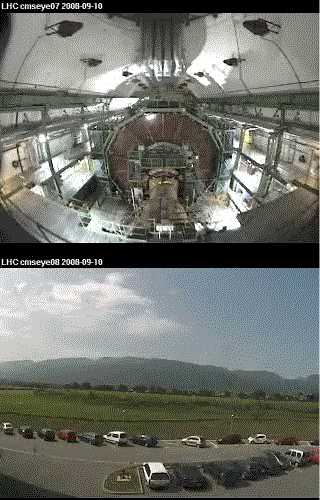
Posted on 06/15/2018 7:29:16 PM PDT by Eddie01
Today, workers at the world’s largest atom smasher are breaking ground on a performance-enhancing upgrade that will allow scientists to conduct even bigger and better physics experiments.
The upgrade will turn the Large Hadron Collider in Geneva, Switzerland into the High-Luminosity Large Hadron Collider (HL-LHC). The upgrade will allow the machine to collide even more particles, potentially helping physicists see new stuff.
“The HL-LHC will enable us to do many things, opening many unexplored areas of research,” Rebeca Gonzalez Suarez, a postdoc research associate at CERN, told Gizmodo in an email.
The Large Hadron Collider is essentially two 16-mile-round rings that overlap in four places. Bunches of protons (or heavier atoms) race around the tracks at nearly the speed of light and collide in one of the four intersections. Enormous detectors surround those crossings and record the particles that coalesce out of the high-energy collisions. Discoveries are made when these resulting collisions behave differently than the existing laws of physics would predict—or when they behave in predicted but never-before-seen ways.
That means making new discoveries faster requires making more collisions. And that’s exactly what the High-Luminosity LHC will do. Currently, the LHC can produce a billion collisions between protons per second, according to a press release. The upgrade, planned for completion in 2026, will up that by five to seven times. It will require new magnets to help squeeze the beams of protons, making collisions between particles more likely, as well as other new parts to increase efficiency.
Naturally, all of this will require quite a bit of construction. A several-year shutdown to finish the upgrade will occur around the end of 2023 to early 2024.
The High-Luminosity LHC ties into some of the larger issues in physics right now, the biggest being that, since the official observation of the Higgs boson, there have been no new particles discovered (at least, not any confirmed ones). Physicists have expected to find something by now. That includes theorized particles that would explain some of fundamental physics’ ugliness or provide an explanation for dark matter, hints of new spatial dimensions, or really any signpost to guide us toward answers to the deepest physics questions.
Such an upgrade would make measurements of particles like the Higgs boson more accurate. Collecting more data faster also means really rare events would happen more frequently, allowing physicists to potentially find anomalies that would lead to new physics.
“The LHC now is a numbers game: we need as much data as possible. To study the Higgs boson after its discovery in 2012 but also because it is pretty clear by now that any other new particles could be rare,” Freya Blekman, physicist at Vrije Universiteit Brussel in Belgium, told Gizmodo. “So we need loads of data.”
The upgrade could also make discoveries happen faster, she said. “The data that was used for the discovery of the Higgs particle was only a fraction of a percent of the data that we need to study it. It would take hundreds of years to gather enough data. So: we are upgrading the accelerator so it only takes us 10 years to get enough data.”
And the Higgs is perhaps where the most obvious benefit will be, said Gonzalez Suarez. “The Higgs boson is still a very new particle and many things about it are still unknown. The increase of luminosity will open a big path toward its full characterization. A clear process to study at the HL-LHC will be double Higgs production, which will be very fun to look for experimentally and will tell us how the Higgs boson interacts with itself.”
After the High-Luminosity LHC, there are already proposals and ideas for future experiments. A future linear collider (which would shoot particles in straight lines instead of rings) would help refine our understanding of physics, hopefully informing physicists as to how they should look for new particles. From there, maybe CERN will build a 62-mile-round ring, going for broke to find whatever they can. In the meantime, other scientists will continue looking for weirder ways to spot particles, by perhaps putting detectors in places that the current detectors can’t observe, like many feet from the central collision.
What would you get if you collided Nancy Pelosi into Chuck Schumer not counting all the excrement splatter?

What the difference between cern.com and match.com?
One is a singles sight, and the other is a singularity sight.
How is an independent party going to be able to verify the results of these experiments?
Geek humor.
Super Geek!
What the difference between match.com and cern.com?
One is a singles sight, and the other is a singularities sight.
I fixed it to up the groan factor.
Waxahatchie, Texas had the collider. The land had all been bought. Then it went to Geneva.
My father in law was part of the Texas collider project when the word came it was shut down.
Sucked, didn’t it. Texas was going through tough financial times and lots of people were counting on the super collider.
Thanks Eddie01.Thanks for the GIF, Herosmith.

As with “Whose Line Is It Anyway”, the (data) points don’t matter.
It’s likely that the LHC will be superseded within 20 or 25 years, by even larger and higher-energy contraptions built in space.

I don’t care what anyone says I think this thing is evil.
maybe THIS one will end the universe.
they have great hopes for its new abilities ...
Will it now be the ‘Extra-Large Hadron Collider”?>...............
Extra-hard. :^)
Disclaimer: Opinions posted on Free Republic are those of the individual posters and do not necessarily represent the opinion of Free Republic or its management. All materials posted herein are protected by copyright law and the exemption for fair use of copyrighted works.